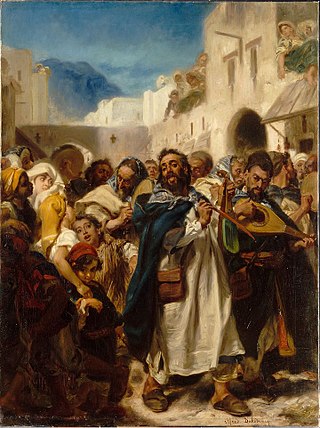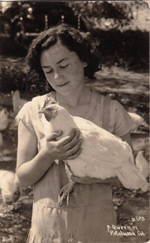Antisemitism is hostility to, prejudice towards, or discrimination against Jews. This sentiment is a form of racism, and a person who harbours it is called an antisemite. Primarily, antisemitic tendencies may be motivated by negative sentiment towards Jews as a people or by negative sentiment towards Jews with regard to Judaism. In the former case, usually presented as racial antisemitism, a person's hostility is driven by the belief that Jews constitute a distinct race with inherent traits or characteristics that are repulsive or inferior to the preferred traits or characteristics within that person's society. In the latter case, known as religious antisemitism, a person's hostility is driven by their religion's perception of Jews and Judaism, typically encompassing doctrines of supersession that expect or demand Jews to turn away from Judaism and submit to the religion presenting itself as Judaism's successor faith—this is a common theme within the other Abrahamic religions. The development of racial and religious antisemitism has historically been encouraged by the concept of anti-Judaism, which is distinct from antisemitism itself.

The history of the Jews in Russia and areas historically connected with it goes back at least 1,500 years. Jews in Russia have historically constituted a large religious and ethnic diaspora; the Russian Empire at one time hosted the largest population of Jews in the world. Within these territories, the primarily Ashkenazi Jewish communities of many different areas flourished and developed many of modern Judaism's most distinctive theological and cultural traditions, while also facing periods of antisemitic discriminatory policies and persecution, including violent pogroms. Some have described a "renaissance" in the Jewish community inside Russia since the beginning of the 21st century; however, the Russian Jewish population has experienced precipitous decline since the dissolution of the USSR which continues to this day, although it is still among the largest in Europe.

There have been Jewish communities in the United States since colonial times, with individuals living in various cities before the American Revolution. Early Jewish communities were primarily composed of Sephardi immigrants from Brazil, Amsterdam, or England.
Jewish studies is an academic discipline centered on the study of Jews and Judaism. Jewish studies is interdisciplinary and combines aspects of history, Middle Eastern studies, Asian studies, Oriental studies, religious studies, archeology, sociology, languages, political science, area studies, women's studies, and ethnic studies. Jewish studies as a distinct field is mainly present at colleges and universities in North America.

Jewish culture is the culture of the Jewish people, from its formation in ancient times until the current age. Judaism itself is not simply a faith-based religion, but an orthoprax and ethnoreligion, pertaining to deed, practice, and identity. Jewish culture covers many aspects, including religion and worldviews, literature, media, and cinema, art and architecture, cuisine and traditional dress, attitudes to gender, marriage, family, social customs and lifestyles, music and dance. Some elements of Jewish culture come from within Judaism, others from the interaction of Jews with host populations, and others still from the inner social and cultural dynamics of the community. Before the 18th century, religion dominated virtually all aspects of Jewish life, and infused culture. Since the advent of secularization, wholly secular Jewish culture emerged likewise.

The history of the Jews in Germany goes back at least to the year 321 CE, and continued through the Early Middle Ages and High Middle Ages when Jewish immigrants founded the Ashkenazi Jewish community. The community survived under Charlemagne, but suffered during the Crusades. Accusations of well poisoning during the Black Death (1346–53) led to mass slaughter of German Jews, while others fled in large numbers to Poland. The Jewish communities of the cities of Mainz, Speyer and Worms became the center of Jewish life during medieval times. "This was a golden age as area bishops protected the Jews, resulting in increased trade and prosperity."
Jewish political movements refer to the organized efforts of Jews to build their own political parties or otherwise represent their interest in politics outside the Jewish community. From the time of the siege of Jerusalem by the Romans to the foundation of Israel the Jewish people had no territory, and, until the 19th century they by-and-large were also denied equal rights in the countries in which they lived. Thus, until the 19th century effort for the emancipation of the Jews, almost all Jewish political struggles were internal, and dealt primarily with either religious issues or issues of a particular Jewish community.
The National Center for Jewish Film is a non-profit motion picture archive, distributor, and resource center. It houses the largest collection of Jewish-themed film and video outside of Israel. Its mission is to collect, restore, preserve, catalogue, and exhibit films with artistic and educational value relevant to the Jewish experience, and to disseminate these materials to the widest possible audience.

Jewish dance is dance associated with Jews and Judaism. Dance has long been used by Jews as a medium for the expression of joy and other communal emotions. Dancing is a favorite pastime and plays a role in religious observance.

The history of Jews in Sweden can be traced from the 17th century, when their presence is verified in the baptism records of the Stockholm Cathedral. Several Jewish families were baptised into the Lutheran Church, a requirement for permission to settle in Sweden. In 1681, for example, 28 members of the families of Israel Mandel and Moses Jacob were baptised in the Stockholm German Church in the presence of King Charles XI of Sweden, the dowager queen Hedvig Eleonora of Holstein-Gottorp, and several other high state officials.

The Holocaust had a deep effect on society both in Europe and the rest of the world, and today its consequences are still being felt, both by children and adults whose ancestors were victims of this genocide.

In Search of Happiness is a 2005 Russian documentary film that poetically follows the lives of Boris and Masha Rak, Soviet Jews who in 1934 moved to the Jewish Autonomous Oblast (JAO) created by the Soviet government in Russian Far East. The film won the Best Documentary award in the Russian Film Festival in 2006.

Song of a Jewish Cowboy is a 2002 documentary about Scott Gerber, a rancher and musician from Sonoma County, California, who sings cowboy music and Yiddish folk songs. The documentary shows clips from his performances and a personal interview with Scott.
The history of the Jews in the Jewish Autonomous Oblast (JAO), Russia, began with the early settlements of 1928.

Stereotypes of Jews are generalized representations of Jews, often caricatured and of a prejudiced and antisemitic nature.

Deborah Hertz, is an American historian whose specialties are modern German history, modern Jewish history and modern European women's history. Her current research focuses on the history of radical Jewish women.

The history of the Jews in Chile dates back to the arrival of Europeans to the country. Over time, Chile has received several contingents of Jewish immigrants. Currently, the Jewish community in Chile comes mainly from the migrations occurred in the 19th and 20th centuries, mostly of Ashkenazi background.
Anabaptists and Jews have had interactions for several centuries, since the origins of Anabaptism in the Radical Reformation in early modern Europe. Due to the insularity of many Anabaptist and Jewish communities, Anabaptist–Jewish relations have historically been limited but there are notable examples of interactions between Anabaptists and Jews. Due to some similarities in dress, culture, and language, Amish and Mennonite communities in particular have often been compared and contrasted to Haredi and Hasidic Jewish communities.
Ashkenormativity refers to a form of Eurocentrism within Ashkenazi Jewish culture that confers privilege on Ashkenazi Jews relative to Jews of Sephardi, Mizrahi, Ethiopian, and other non-Ashkenazi backgrounds, as well as to the assumption that Ashkenazi culture is the default Jewish culture. The term is most commonly used in the United States, where the majority of Jews are Ashkenazi. Ashkenormativity is also alleged to exist in Israel, where Ashkenazi Jews experience cultural prominence despite no longer constituting a majority.
Black Jews in New York City comprise one of the largest communities of Black Jews in the United States. Black Jews have lived in New York City since colonial times, with organized Black-Jewish and Black Hebrew Israelite communities emerging during the early 20th century. Black Jewish and Black Hebrew Israelite communities have historically been centered in Harlem, Brooklyn, The Bronx, and Queens. The Commandment Keepers movement originated in Harlem, while the Black Orthodox Jewish community is centered in Brooklyn. New York City is home to four historically Black synagogues with roots in the Black Hebrew Israelite community. A small Beta Israel (Ethiopian-Jewish) community also exists in New York City, many of whom emigrated from Israel. Black Hebrew Israelites are not considered Jewish by the New York Board of Rabbis, an organization representing mainstream Rabbinic Judaism. However, some Black Hebrew Israelite individuals in New York City are recognized as Jewish due to converting through the Orthodox, Conservative, or other Jewish movements.












